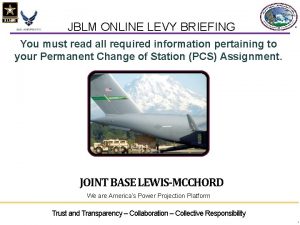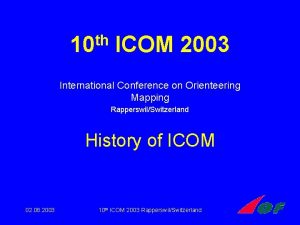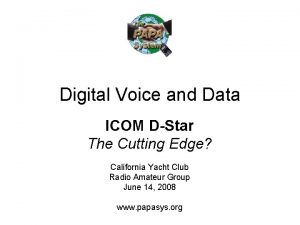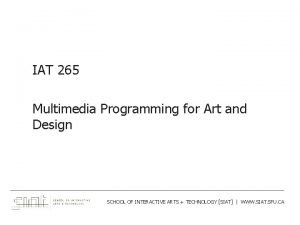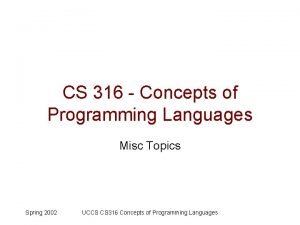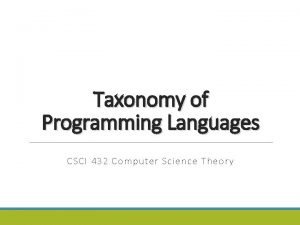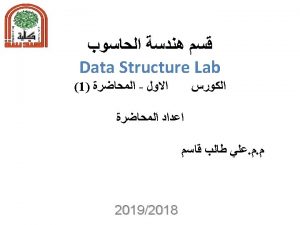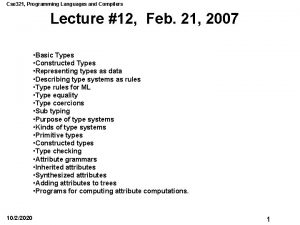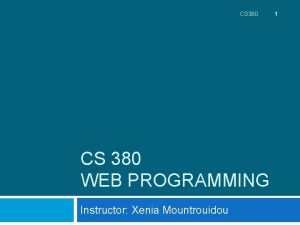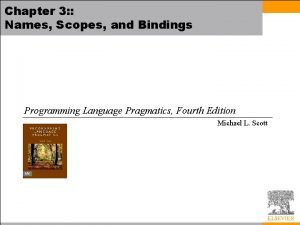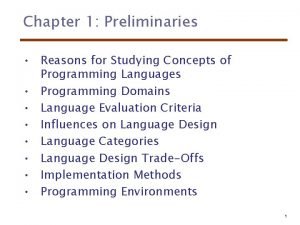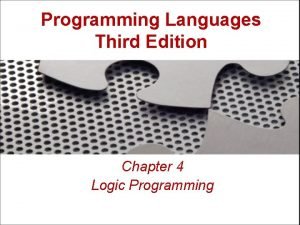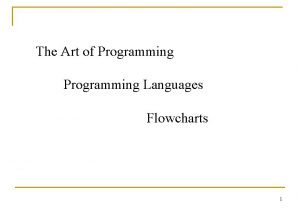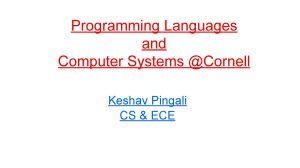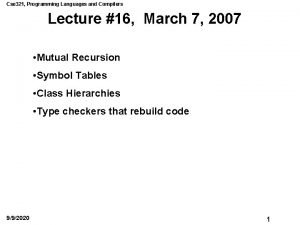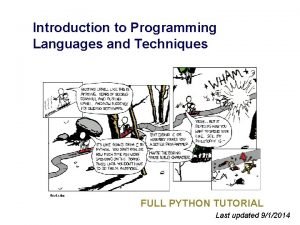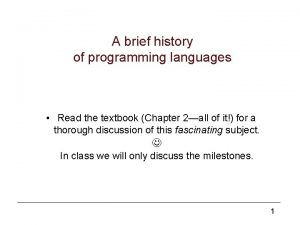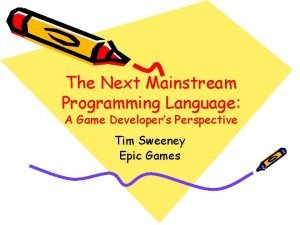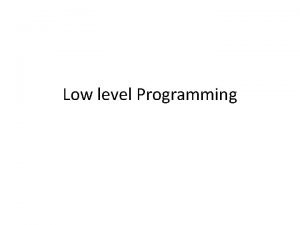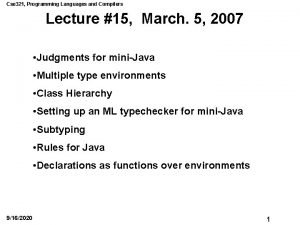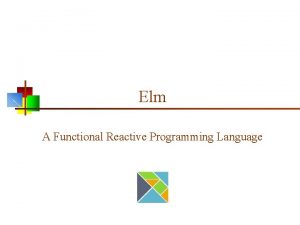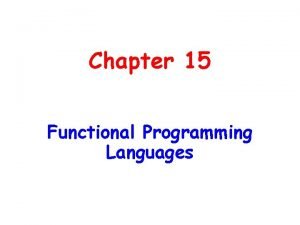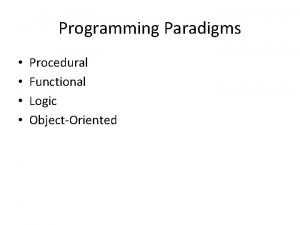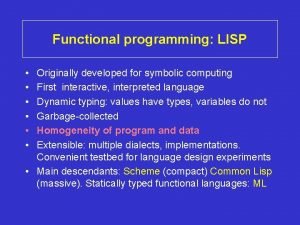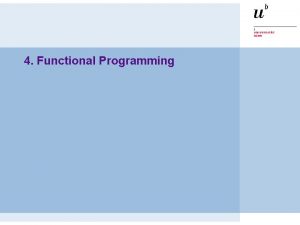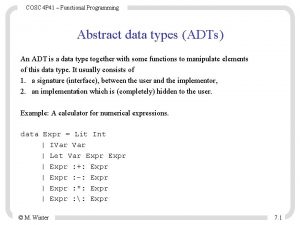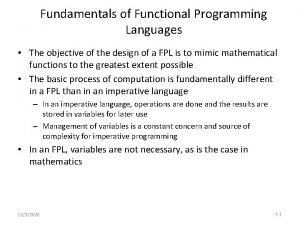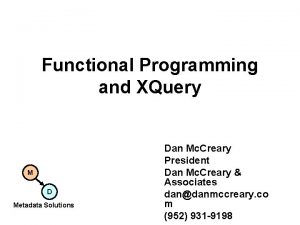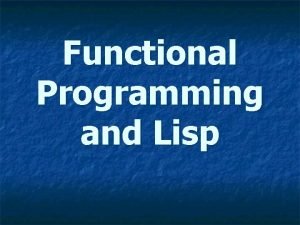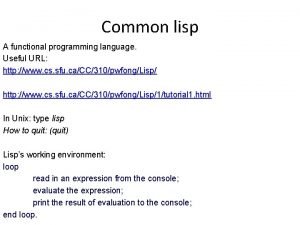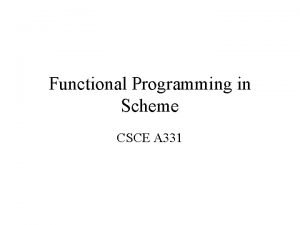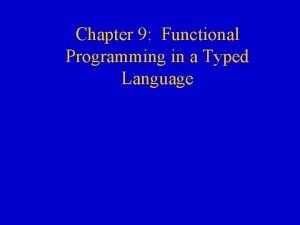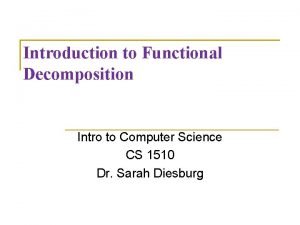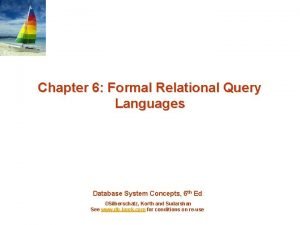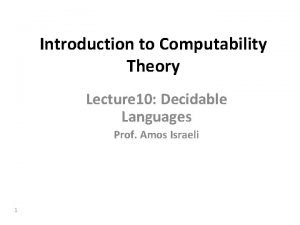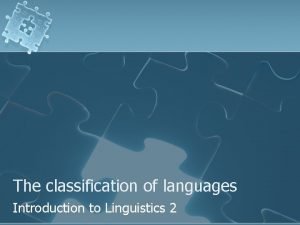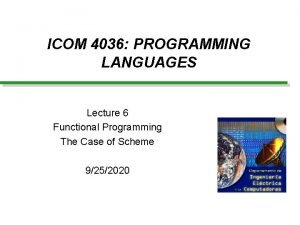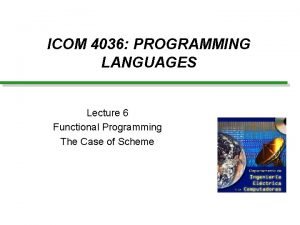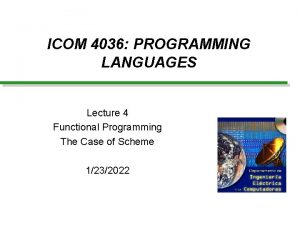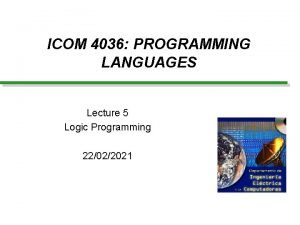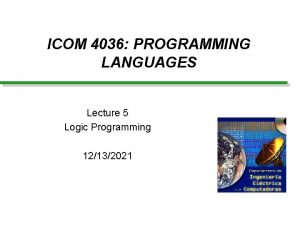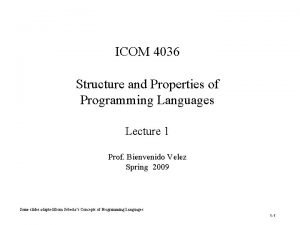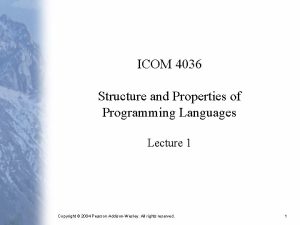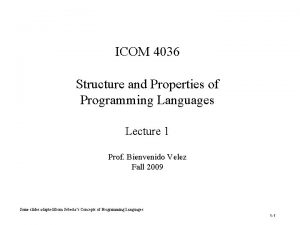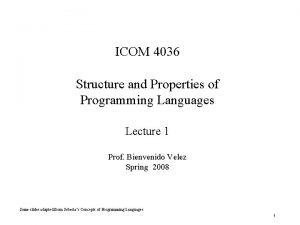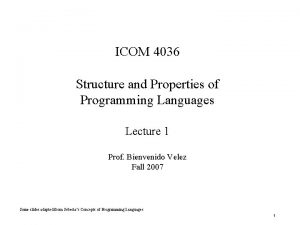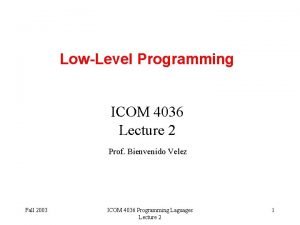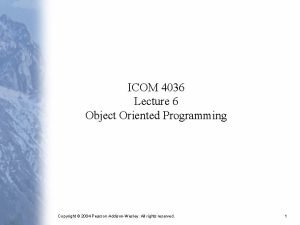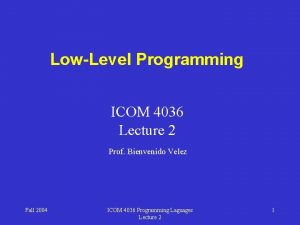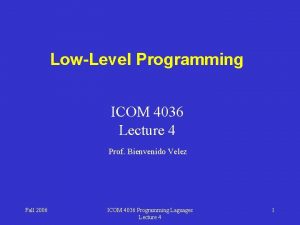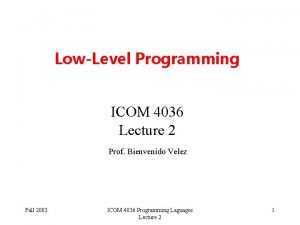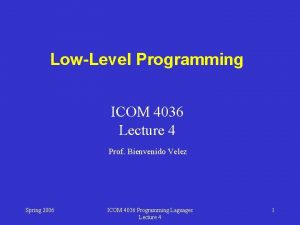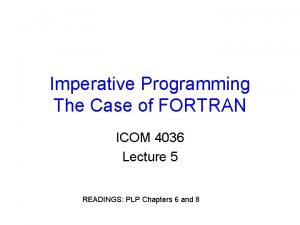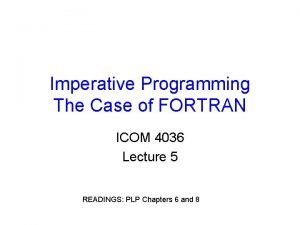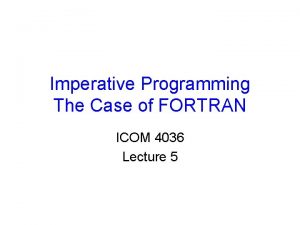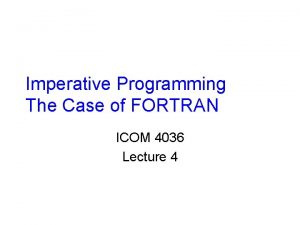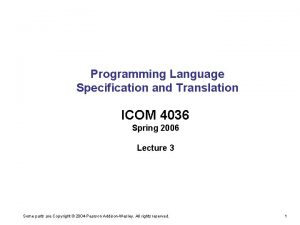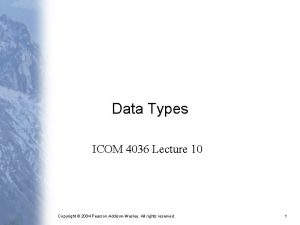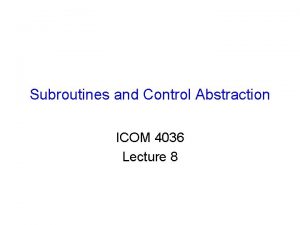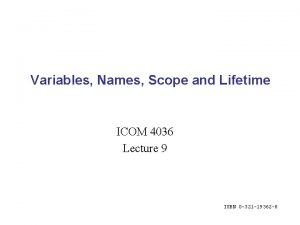ICOM 4036 PROGRAMMING LANGUAGES Lecture 5 Functional Programming


































































- Slides: 66

ICOM 4036: PROGRAMMING LANGUAGES Lecture 5 Functional Programming The Case of Scheme 9/25/2020

Required Readings ® Texbook (R. Sebesta Concepts of PLs) w Chapter 15: Functional Programming Languages ® Scheme Language Description w Revised Report on the Algorithmic Language Scheme (available at the course website in Postscript format) At least one exam question will cover these readings

Administrivia ® Exam II Date w March 25, 2004 in class

Functional Programming Impacts Functional programming as a minority discipline in the field of programming languages nears a certain resemblance to socialism in its relation to conventional, capitalist economic doctrine. Their proponents are often brilliant intellectuals perceived to be radical and rather unrealistic by the mainstream, but little-by-little changes are made in conventional languages and economics to incorporate features of the radical proposals. - Morris [1982] “Real programming in functional languages

Functional Programming Highlights ® Conventional Imperative Languages Motivated by von ® ® ® ® Neumann Architecture Functional programming= New machanism for abstraction Functional Composition = Interfacing Solutions as a series of function application f(a), g(f(a)), h(g(f(a))), . . . . Program is an notation or encoding for a value Computation proceeds by rewriting the program into that value Sequencing of events not as important In pure functional languages there is no notion of state

Functional Programming Phylosophy ® Symbolic computation / Experimental programming ® Easy syntax / Easy to parse / Easy to modify. ® Programs as data ® High-Order functions ® Reusability ® No side effects (Pure!) ® Dynamic & implicit type systems ® Garbage Collection (Implicit Automatic Storage management)

Garbage Collection ® At a given point in the execution of a program, a memory location is garbage if no continued execution of the program from this point can access the memory location. ® Garbage Collection: Detects unreachable objects during program execution & it is invoked when more memory is needed ® Decision made by run-time system, not by the program ( Memory Management).

What’s wrong with this picture? ® Theoretically, every imperative program can be written as a functional program. ® However, can we use functional programming for practical applications? (Compilers, Graphical Users Interfaces, Network Routers, . . . ) Eternal Debate: But, most complex software today is written in imperative languages

LISP ® Lisp= List Processing ® Implemented for processing symbolic information ® Mc. Carthy: “Recursive functions of symbolic ® ® ® expressions and their computation by machine” Communications of the ACM, 1960. 1970’s: Scheme, Portable Standard Lisp 1984: Common Lisp 1986: use of Lisp ad internal scripting languages for GNU Emacs and Auto. CAD.

History (1) Fortran FLPL (Fortran List Processing Language) No recursion and conditionals within expressions. Lisp (List processor)

History (2) ® Lisp (List Processor, Mc. Carthy 1960) * Higher order functions * conditional expressions * data/program duality * scheme (dialect of Lisp, Steele & Sussman 1975) ® APL (Inverson 1962) * Array basic data type * Many array operators

History (3) ® IFWIM (If You Know What I Mean, Landin 1966) * Infix notation * equational declarative ® ML (Meta Language – Gordon, Milner, Appel, Mc. Queen 1970) * static, strong typed language * machine assisted system formal proofs * data abstraction * Standard ML (1983)

History (4) ® FP (Backus 1978) * Lambda calculus * implicit data flow specification ® SASL/KRC/Miranda (Turner 1979, 1982, 1985) * math-like sintax

Scheme: A dialect of LISP ® READ-EVAL-PRINT Loop (interpreter) ® Prefix Notation ® Fully Parenthesized ® (* (* (+ 3 5) (- 3 (/ 4 3))) (- (* (+ 4 5) (+ 7 6)) 4)) A scheme expression results from a pre-order traversal of an expression syntax tree

Scheme Definitions and Expressions ® (define pi 3. 14159) pi ® p. I 3. 14159 ® (* 5 7 ) 35 ® (+ 3 (* 7 4)) 31 ; bind a variable to a value ; parenthesized prefix notation

Scheme Functions (define (square x) (*x x)) square ® (square 5) 25 ® ((lambda (x) (*x x)) 5) ; unamed function 25 ® The benefit of lambda notation is that a function value can appear within expressions, either as an operator or as an argument. Scheme programs can construct functions dynamically

Functions that Call other Functions ® (define square (x) (* x x)) ® (define square (lambda (x) (* x x))) ® (define sum-of-squares (lambda (x y) (+ (square x) (square y)))) Named procedures are so powerful because they allow us to hide details and solve the problem at a higher level of abstraction.

Scheme Conditional Expressions ® (If P E 1 E 2) ® (cond (P 1 E 1) . . . (Pk Ek) (else Ek+1)) ; if P then E 1 else E 2 ; if P 1 then E 1 ; else if Pk then Ek ; else Ek+1 ® (define (fact n) (if (equal? n 0) 1 (*n (fact (- n 1))) ) )

Blackboard Exercises ® Fibinacci ® GCD

Scheme: List Processing (1) ® (null? ( )) ® ® ® #t (define x ‘((It is great) to (see) you)) x (car x) (It is great) (cdr x) Quote delays (to (see) you) evaluation of (car x)) expression It (cdr (car x)) (is great)

Scheme: List Processing (2) ® (define a (cons 10 20)) ® (define b (cons 3 7)) Not a list!! (not null terminated) ® (define c (cons a b)) ® (define a (cons 10 (cons 20 ‘())) ® (define a (list 10 20) Equivalent

Scheme List Processing (3) ® (define (lenght x) (cond ((null? x) 0) (else (+ 1 (length (cdr x)))) )) ® (define (append x z) (cond ((null? x) z) (else (cons (car x) (append (cdr x) z ))))) ® ( append `(a b c) `(d)) (a b c d)

Backboard Exercises ® Map(List, Funtion) ® Fold(List, Op, Init) ® Fold-map(List, Op, Init, Function)

Variables, Names, Scope and Lifetime

What is Variable? ® Imperative view w. A variable is an abstraction of a memory (state) cell ® Functional view w. A variable is an abstraction of a value ® Every definition introduces a new variable ® Two distinct variables may have the same name ® Variables can be characterized as a sextuple of attributes: <name, address, value, type, scope, lifetime>

The Concept of Binding ® A Binding is an association, such as between an attribute and an entity, or between an operation and a symbol, or between a variable and a value. ® Binding time is the time at which a binding takes place.

Possible Binding Times ® Language design time wbind operator symbols to operations ® Language implementation time wbind floating point type to a representation ® Compile time wbind a variable to a type in C or Java ® Load time wbind a FORTRAN 77 variable to a memory cell wa C static variable ® Runtime wbind a nonstatic local variable to a memory cell

The Concept of Binding: Static vs. Dynamic ® A binding is static if it first occurs before run time and remains unchanged throughout program execution. ® A binding is dynamic if it first occurs during execution or can change during execution of the program. We will discuss the choices in selecting binding times for different variable attributes

Design Issues for Names ® Maximum length? ® Are connector characters allowed? ® Are names case sensitive? ® Are special words reserved words or keywords? < name, address, value, type, scope, lifetime >

Address or Memory Cell ® The physical cell or collection of cells associated with a variable ® Also called and l-value ® A variable may have different addresses at different times during execution ® A variable may have different addresses at different places in a program < name, address, value, type, scope, lifetime >

Aliases ® If two variable names can be used to access the same memory location, they are called aliases ® Aliases are harmful to readability (program readers must remember all of them) ® How can aliases be created: w. Pointers, reference variables, C and C++ unions, (and through parameters - discussed in Chapter 9) ® Some of the original justifications for aliases are no longer valid; e. g. memory reuse in FORTRAN w. Replace them with dynamic allocation

Values ® Value – the “object” with which the variable is associated at some point in time ® Also known as the r-value of the variable < name, address, value, type, scope, lifetime >

Types ® Determines the range of values that a variable may be bound to and the set of operations that are defined for values of that type ® Design Issues for Types w. When does the binding take place? (Dynamic versus static) w. Is the type declared explicitly or implicitly? w. Can the programmer create new types? w. When are two types compatible? (structural versus name equivalence) w. When are programs checked for type correctness? (compile time versus runtime) < name, address, value, type, scope, lifetime >

Scope ® The scope of a variable is the range of statements over which it is visible ® The nonlocal variables of a program unit are those that are visible but not declared there ® The scope rules of a language determine how references to names are associated with variables < name, address, value, type, scope, lifetime >

Static Scope ® Binding occurs at compile time ® Scope based on program text ® To connect a name reference to a variable, you (or the compiler) must find the declaration that is active ® Search process: search declarations, first locally, then in increasingly larger enclosing scopes, until one is found for the given name ® Enclosing static scopes (to a specific scope) are called its static ancestors; the nearest static ancestor is called a static parent

Static Scope pros and cons ® Static scope allows freedom of choice for local variable names ® But, global variables can be hidden from a unit by having a "closer" variable with the same name ® C++ and Ada allow access to these "hidden" variables w. In Ada: unit. name w. In C++: class_name: : name

Static Scope ® Blocks w. A method of creating static scopes inside program units--from ALGOL 60 w. Examples: C and C++: for (. . . ) { int index; . . . } Ada: declare LCL : FLOAT; begin. . . end

Static Scope Example ® Consider the example: MAIN A C B D E

Static Scope Example MAIN X: int A …X … C Variable X is FREE in A MAIN D B A X: int E C B D Static links E

Static Scope Example Assume: MAIN calls A and B A calls C and D B calls A and E MAIN A A. K. A Dynamic Function Call Graph C B D E Dynamic links

Blackboard Exercise ® Write a scheme program that complies with the given scope hierarchy and call graph. ® What definition of variable x is active during the call of B to A?

Static Scope ® Suppose the spec is changed so that D must now access some data in B ® Solutions: w Put D in B (but then C can no longer call it and D cannot access A's variables) w Move the data from B that D needs to MAIN (but then all procedures can access them) ® Same problem for procedure access

Dynamic Scope ® Based on calling sequence of program units, not their textual layout (temporal versus spatial) ® References to variables are connected to declarations by searching back through the chain of subprogram calls that forced execution to this point

Scope Example 2 MAIN - declaration of x SUB 1 - declaration of x. . . call SUB 2. . . - reference to x. . . call SUB 1 … MAIN calls SUB 1 calls SUB 2 uses x

Scope Example 2 ® Static scoping w. Reference to x is to MAIN's x ® Dynamic scoping w. Reference to x is to SUB 1's x ® Evaluation of Dynamic Scoping: w. Advantage: convenience w. Disadvantage: poor readability

Lifetime ® The lifetime of a variable is the time during which it is bound to a particular memory cell

Categories of Variables by Lifetime ® Static wbound to memory cells before execution begins and remains bound to the same memory cell throughout execution. e. g. all FORTRAN 77 variables, C static variables w. Advantages: efficiency (direct addressing), historysensitive subprogram support w. Disadvantage: lack of flexibility (no recursion)

Categories of variables by lifetimes ® Stack-dynamic w. Storage bindings are created for variables when their declaration statements are elaborated. w. If scalar, all attributes except address are statically bound w e. g. local variables in C subprograms and Java methods w. Advantage: allows recursion; conserves storage w. Disadvantages: w. Overhead of allocation and deallocation w. Subprograms cannot be history sensitive w. Inefficient references (indirect addressing)

Categories of variables by lifetimes ® Explicit heap-dynamic w. Allocated and deallocated by explicit directives, specified by the programmer, which take effect during execution w. Referenced only through pointers or references e. g. dynamic objects in C++ (via new and delete) all objects in Java w. Advantage: provides for dynamic storage management w. Disadvantage: inefficient and unreliable

Categories of variables by lifetimes ® Implicit heap-dynamic w. Allocation and deallocation caused by assignment statements e. g. all variables in APL; all strings and arrays in Perl and Java. Script w. Advantage: flexibility w. Disadvantages: w. Inefficient, because all attributes are dynamic w. Loss of error detection

Scheme: Implemeting Stacks as Lists ® Devise a representation for staks and implementations for the functions: push (h, st) returns stack with h on top (st) returns top element of stack pop(st) returns stack with top element removed ® Solution: represent stack by a list push=cons top=car pop=cdr

List Representation for Binary Search Trees 14 '(14 (7 () (12()())) (26 (20 (17()()) (31()()))) 7 26 12 20 17 31

Binary Search Tree Data Type ® (define make-tree (lambda (n l r) (list n l r))) ® (define empty-tree? (lambda (bst) (null? bst))) ® (define label (lambda (bst) (car bst))) ® (define left-subtree (lambda (bst) (car (cdr bst)))) ® (define right-subtree (lambda (bst) (car (cdr bst)))))

Searching a Binary Search Tree (define find (lambda (n bst) (cond ((empty-tree? bst) #f) ((= n (label bst)) #t) ((< n (label bst)) (find n (left-subtree bst))) ((> n (label bst)) (find n (right-subtree bst))))))

Recovering a Binary Search Tree Path (define path (lambda (n bst) (if (empty-tree? bst) ‘() ; ; didn't find it (if (< n (label bst)) (cons 'L (path n (left-subtree bst))) ; ; in the left subtree (if (> n (label bst)) (cons 'R (path n (right-subtree bst))) ; ; in the right subtree '() ; ; n is here, quit ) ))

List Representation of Sets Math { 1, 2, 3, 4 } Scheme (list 1 2 3 4)

List Representation of Sets ® (define (member? e set) (cond ((null? set) #f) ((equal? e (car set)) #t) (else (member? e (cdr set))) ) ) ® (member? 4 (list 1 2 3 4)) > #t

Set Difference (define (setdiff lis 1 lis 2) (cond ((null? lis 1) '()) ((null? lis 2) lis 1) ((member? (car lis 1) lis 2) (setdiff (cdr lis 1) lis 2)) (else (cons (car lis 1) (setdiff (cdr lis 1) lis 2))) ) )

Set Intersection (define (intersection lis 1 lis 2) (cond ((null? lis 1) '()) ((null? lis 2) '()) ((member? (car lis 1) lis 2) (cons (car lis 1) (intersection (cdr lis 1) lis 2))) (else (intersection (cdr lis 1) lis 2)) ) )

Set Union (define (union lis 1 lis 2) (cond ((null? lis 1) lis 2) ((null? lis 2) lis 1) ((member? (car lis 1) lis 2) (cons (car lis 1) (union (cdr lis 1) (setdiff lis 2 (cons (car lis 1) '()))))) (else (cons (car lis 1) (union (cdr lis 1) lis 2))) ) )

Functional Languages: Remark 1 ® In Functional Languages, you can concern yourself with the higher level details of what you want accomplished, and not with the lower details of how it is accomplished. In turn, this reduces both development and maintenance cost

Functional Languages: Remark 2 ® Digital circuits are made up of a number of functional units connected by wires. Thus, functional composition is a direct model of this application. This connection has caught the interest of fabricants and functional languages are now being used to design and model chips w. Example: Products form Cadence Design Systems, a leading vendor of electronic design automation tools for IC design, are scripted with SKILL (a proprietary dialect of LISP)

Functional Languages: Remark 3 ® Common Language Runtime (CLR) offers the possibility for multi-language solutions to problems within which various parts of the problem are best solved with different languages, at the same time offering some layer of transparent inter-language communication among solution components. w. Example: Mondrian (http: //www. mondrian-script. org) is a purely functional language specifically designed to leverage the possibilities of the. NET framework. Mondrian is designed to interoperate with object-oriented languages (C++, C#)

Functional Languages: Remark 4 ® Functional languages, in particular Scheme, have a significant impact on applications areas such as w Artificial Intelligence (Expert systems, planning, etc) w Simulation and modeling w Applications programming (CAD, Mathematica) w Rapid prototyping w Extended languages (webservers, image processing) w Apps with Embedded Interpreters (EMACS lisp)

Functional Languages: Remark 5 ® If all you have is a hammer, then everything looks like a nail.

END
 Army levy packet
Army levy packet Icom
Icom Icom
Icom Yaesu ftm-400xdr vs icom 5100
Yaesu ftm-400xdr vs icom 5100 Papasys
Papasys 01:640:244 lecture notes - lecture 15: plat, idah, farad
01:640:244 lecture notes - lecture 15: plat, idah, farad Iat 265
Iat 265 Introduction to programming languages
Introduction to programming languages If programming languages were cars
If programming languages were cars Lisp_q
Lisp_q Vineeth kashyap
Vineeth kashyap Types of programming languages
Types of programming languages Alternative programming languages
Alternative programming languages Middle level programming languages
Middle level programming languages Programming languages
Programming languages Cs 421 programming languages and compilers
Cs 421 programming languages and compilers Xenia programming languages
Xenia programming languages Storage management in programming languages
Storage management in programming languages Plc
Plc Reasons for studying concepts of programming languages
Reasons for studying concepts of programming languages Programming languages
Programming languages Transmission programming languages
Transmission programming languages The art of programming
The art of programming Real time programming language
Real time programming language Tiny programming language
Tiny programming language Multithreading program in java
Multithreading program in java Advantages and disadvantages of programming languages
Advantages and disadvantages of programming languages Joey paquet
Joey paquet Cornell programming languages
Cornell programming languages Programming languages
Programming languages Cse 340 principles of programming languages
Cse 340 principles of programming languages Cs 421 uiuc
Cs 421 uiuc Cxc it
Cxc it Xkcd programming
Xkcd programming Brief history of programming languages
Brief history of programming languages Mainstream programming languages
Mainstream programming languages Imperative programming languages
Imperative programming languages Low level programming languages
Low level programming languages Programming languages
Programming languages Real-time systems and programming languages
Real-time systems and programming languages Integral data type
Integral data type Plasma enzyme
Plasma enzyme Functional and non functional
Functional and non functional Space maintainers classification
Space maintainers classification Functional and non functional plasma enzymes
Functional and non functional plasma enzymes C programming lecture
C programming lecture Elm programming language
Elm programming language Fundamentals of functional programming language
Fundamentals of functional programming language Procedural functional object oriented
Procedural functional object oriented Lisp functional programming
Lisp functional programming Functional programming roadmap
Functional programming roadmap Cosc 4p41
Cosc 4p41 Functional programming fundamentals
Functional programming fundamentals Functional programming
Functional programming Lisp functional programming
Lisp functional programming Is lisp a functional programming language
Is lisp a functional programming language Scheme functional programming
Scheme functional programming Typed functional programming
Typed functional programming Functional decomposition programming
Functional decomposition programming Programing adalah
Programing adalah Greedy vs dynamic
Greedy vs dynamic System programming
System programming Perbedaan linear programming dan integer programming
Perbedaan linear programming dan integer programming Integer programming vs linear programming
Integer programming vs linear programming Formal relational query languages
Formal relational query languages Decidable languages
Decidable languages Typological classification of languages
Typological classification of languages
